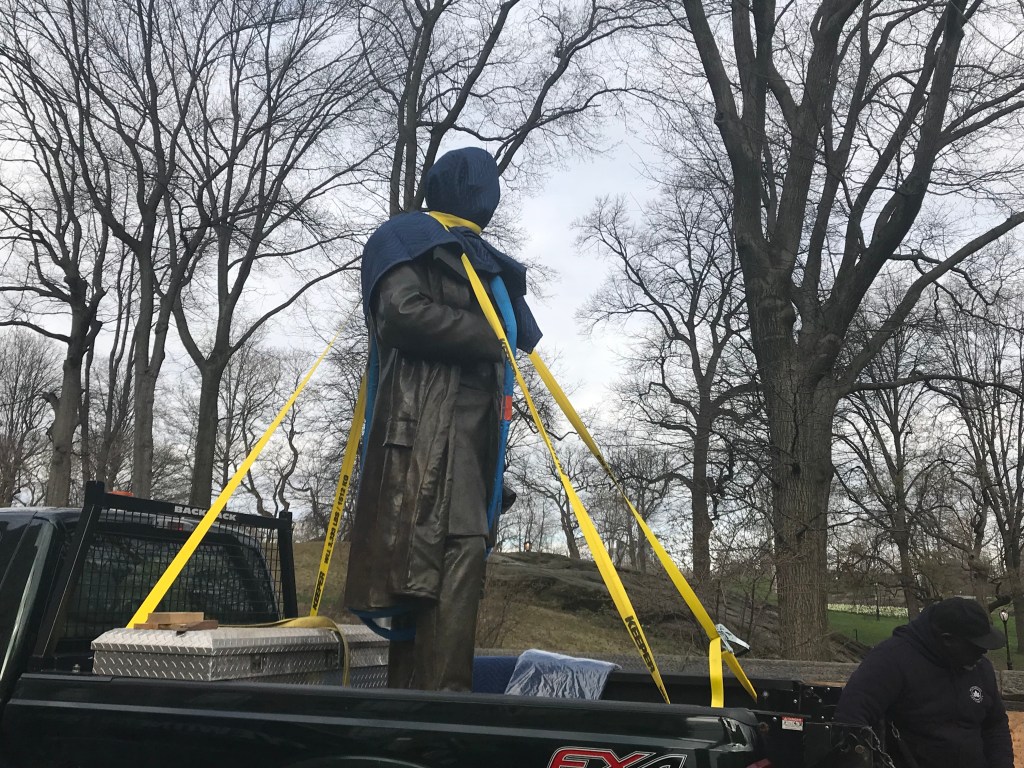This morning, a bronze monument of J. Marion Sims—a gynecologist who experimented on female slaves without anesthesia or consent in the late 1800s—was taken down from Central Park and will be relocated to the Green-Wood Cemetery in Brooklyn. A modest crowd of press, advocates, and doctors clustered a few feet from the monument as reps from the New York City Public Design Commission pulled the statue down and transferred it onto a flatbed truck.
Sims’s statue was erected in 1934 in front of the New York Academy of Medicine, not far from what used to be the Women’s Hospital, which he founded. He’s been celebrated for decades as the “father of modern gynecology,” mainly for his surgical technique for the repair of vesicovaginal fistula, a complication of childbirth. He arrived at this innovation by experimenting on women who, as he ascertained, didn’t need anesthesia because fistula surgery was not “painful enough to justify the trouble and risk attending their administration.”
Videos by VICE
The statue’s head was covered and a rope was put around the neck to steady it, creating an image that eerily resembled a public hanging. For a full hour after the statue was loaded, bystanders spoke to the press and to each other about what the city’s decision signified to them. “The man’s legacy rests on terrorizing black women’s bodies. We must affirm life, not abuse power,” says Catherine Feliz, an advocate and doula who came to watch the statue being taken down. “Healing our world is dependent upon the liberation of black women.”

Last year, a powerful image of four women standing in front of Sims’s statue in hospital gowns with red paint splattered around their pelvic area went viral. The caption on Facebook read, “J. Marion Sims was a gynecologist in the 1800s who purchased Black women slaves and used them as guinea pigs for his untested surgical experiments. He repeatedly performed genital surgery on Black women WITHOUT ANESTHESIA because according to him, ‘Black women don’t feel pain.’”
Other public expressions of outrage, protests, and formal complaints from those in the medical community resulted in the commission’s decision, in January, to move the statue of the controversial doctor to a less conspicuous place. But many feel it’s a “slap in the face” that they’re not fully getting rid of it.
A post from East Harlem Preservation that followed the city’s decision read: “Rather than abolishing the theme of a white southern doctor who experimented on enslaved Black women without anesthesia or informed consent, the city has chosen to keep the Sims pedestal (and signage) in place with new language added ‘to provide context’ for his work.”

Still, Harriet Washington, a medical ethicist who was one of the catalysts of the movement, tells me how gratifying it is to rip the mask off a celebrated historical figure such as Sims.
“Other history books give a sanitized version. It portrayed him as a women’s champion, a medical hero,” says Washington, who wrote Medical Apartheid: The Dark History of Medical Experimentation on Black Americans from Colonial Times to the Present. “But he wasn’t at all. When you read his own work you find out that he was a medical monster.”
Sign up for our newsletter to get the best of Tonic delivered to your inbox weekly.




